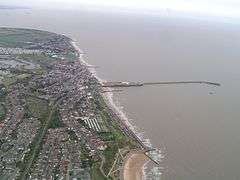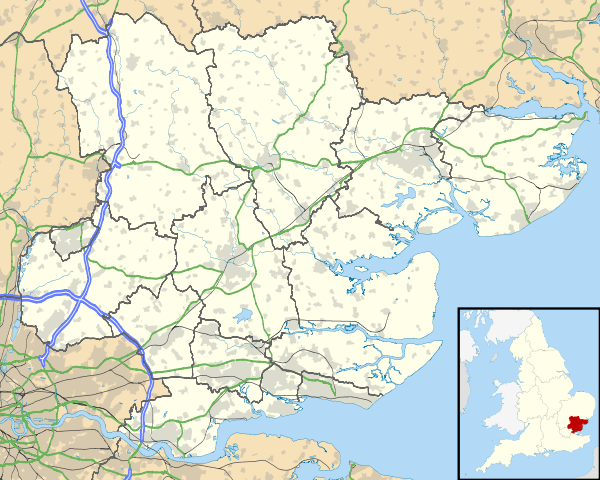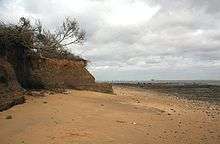Walton-on-the-Naze
Walton-on-the-Naze is a small town in Essex, England, on the North Sea coast in the Tendring District. It is north of Clacton and south of the port of Harwich. It abuts Frinton-on-Sea to the south, and is part of the parish of Frinton and Walton. It is a resort town, with a population of 12,054 (according to the 2011 census).[2] The town is in the civil parish of Frinton and Walton. It attracts many visitors, The Naze being the main attraction. There is also a pier.
| Walton-on-the-Naze | |
|---|---|
 Walton on the Naze | |
 Walton-on-the-Naze Location within Essex | |
| OS grid reference | TM246214 |
| Civil parish | |
| District | |
| Shire county | |
| Region | |
| Country | England |
| Sovereign state | United Kingdom |
| Post town | WALTON ON THE NAZE[1] |
| Postcode district | CO14 |
| Dialling code | 01255 |
| Police | Essex |
| Fire | Essex |
| Ambulance | East of England |
| UK Parliament | |
The parish was earlier known as Eadolfenaesse and then as Walton-le-Soken.[3] The name 'Walton' is a common one meaning a 'farmstead or village of the Britons',[4] while 'Soken' denotes the soke (an area of special jurisdiction) that included Thorpe, Kirby and Walton, which were not under the see of London but under the chapter of St Paul's Cathedral.
Walton had a HM Coastguard team and was home to the Thames MRCC (Maritime Rescue Coordination Centre), organising rescues from Southwold to Herne Bay. It closed in June 2015[5] as part of a Maritime and Coastguard Agency (MCA) modernisation programme, transferring its operations to a national centre in Fareham on the south coast.
Walton-on-the-Naze railway station is on a branch of the Sunshine Coast Line.
Along the coast there are many fossils to be found. Some rocks are up to 50 million years old. Rocks include red crag and London clay.
The Naze
"Naze" derives from Old English næss "ness, promontory, headland". In 1722 Daniel Defoe mentions the town calling it "Walton, under the Nase".[6]
The Naze is a peninsula north of the town. It is important for migrating birds and has a small nature reserve. The marshes of Hamford Water behind the town are also of ornithological interest, with wintering ducks and Brent geese. Many bird watchers visit at migration times.
The Hanoverian tower (more commonly known as the Naze Tower) at the start of the open area of the Naze was a sea mark to assist ships on this otherwise fairly featureless coast. It is now privately owned and open to visitors.

Originally, Walton was a farming village situated miles inland. Over the centuries a large extent of land has been lost to the sea due to coastal erosion. The site of the medieval village of Walton now lies nine miles out to sea; its old church finally succumbed in July 1798.[7] Its last service was held on 22 July 1798. This loss of land to the sea is recorded on a Canon's stall in St Paul's Cathedral with the inscription Consumpta per Mare.
The Naze continues to erode rapidly (at about 2 metres per year),[8] threatening the tower and wildlife. The Naze Protection Society was formed to campaign for erosion controls. The Naze has become popular for school fieldwork to investigate erosion and ways to protect the coast. Protection includes a sea wall, a riprap, groynes and a permeable groyne as well as drainage. Millions of tons of sand have been added to the beach to replenish it and stop the cliff eroding. However, the cliff near Naze Tower is greatly eroded. It is receding fast, and within 50 years Naze Tower may tumble into the sea like the pill boxes that can be seen on the beach.
The cliffs themselves are a Site of Special Scientific Interest (SSSI), the base of which is London Clay (54 million years old) which is overlaid with a 2-million-year-old sandy deposit of Red Crag. This sandy deposit contains many fossils including bivalve and gastropod shells, sharks' teeth and whale bones. The clay base is considered one of the best sites for pyritised fossils (mainly wood) and for bird bones (which are very rare).[9]
Climate
Like the rest of the British Isles, Walton-on-the-Naze has an oceanic climate, with slightly more marine influence than nearby inland areas due to its position on the North Sea coast.
| Climate data for Walton-on-the-Naze 1981-2010 averages | |||||||||||||
|---|---|---|---|---|---|---|---|---|---|---|---|---|---|
| Month | Jan | Feb | Mar | Apr | May | Jun | Jul | Aug | Sep | Oct | Nov | Dec | Year |
| Average high °C (°F) | 6.6 (43.9) |
7.2 (45.0) |
9.7 (49.5) |
11.7 (53.1) |
15.4 (59.7) |
18.5 (65.3) |
21.2 (70.2) |
21.0 (69.8) |
18.6 (65.5) |
14.8 (58.6) |
10.5 (50.9) |
7.5 (45.5) |
13.6 (56.5) |
| Average low °C (°F) | 2.1 (35.8) |
2.3 (36.1) |
3.6 (38.5) |
5.6 (42.1) |
8.8 (47.8) |
11.7 (53.1) |
14.5 (58.1) |
14.2 (57.6) |
12.1 (53.8) |
9.3 (48.7) |
5.5 (41.9) |
2.8 (37.0) |
7.7 (45.9) |
| Average precipitation mm (inches) | 46.7 (1.84) |
39.8 (1.57) |
39.5 (1.56) |
35.9 (1.41) |
36.7 (1.44) |
36.5 (1.44) |
44.9 (1.77) |
51.7 (2.04) |
53.5 (2.11) |
57.8 (2.28) |
56.1 (2.21) |
49.9 (1.96) |
548.8 (21.61) |
| Mean monthly sunshine hours | 63.2 | 88.1 | 121.7 | 192.8 | 222.8 | 227.0 | 224.2 | 222.2 | 161.5 | 123.3 | 78.3 | 53.5 | 1,777.9 |
| Source: Met Office[10] | |||||||||||||
Walton Pier
The original pier was built in 1830, one of the earliest in the country. It was built for landing goods and passengers from steamers and was originally 300 ft long (91 m), later extended to 800 feet (240 m). The pier was badly damaged in a storm in January 1871.[11] A second pier opened in 1880, which also did not last.[11]
In 1895, the Walton-on-the-Naze hotel and pier company (then owners of the pier) opened a replacement pier 500 ft longer (150 m) than the original. Several extensions have increased the pier's length to 2,600 ft (790 m), the third longest in the UK. When the new pier opened in 1895, an electric tramway was installed to take passengers from the steamers to the front of the pier. This was in use until 1935 when it was upgraded to a battery-powered carriage. In 1945 fire damaged the pier, and the carriage was replaced by a diesel locomotive train. This was removed during the 1970s.
Today, the pier remains a popular attraction, with amusements and funfair rides in a hangar-type building. Beyond this, the pier extends into a promenade popular with anglers.
War memorial
The unusual war memorial commemorates a Halifax crew who all died when they crashed on the Naze. It also has a tribute to Herbert George Columbine, who was awarded the VC and after whom the local leisure centre is named, and a tribute to those lost from HMS Conquest during World War I.
Lifeboat house
The old lifeboat house on East Terrace dates from 1884: it now houses the Walton Maritime Museum. It was designed by C H Cooke and is a grade II listed building.[12]
Notable residents
- Frank Paton, artist, moved to Walton-on-the-Naze shortly before his death in 1909.
- Ben Raemers, professional skateboarder, lived in Walton-on-the-Naze and grew up there, where he first started skateboarding at the age of 10.
Governance
Although the Civil Parish is now shown under Frinton and Walton, an electoral ward in the name of Walton still exists. The population of this ward at the 2011 Census was 4,372.[13]
Cultural references
Walton was the inspiration for the fictional Balford-le-Nez in Elizabeth George's detective story Deception on His Mind.
Hamford Water and the town of Walton-on-the-Naze are the location of Arthur Ransome's Swallows and Amazons series book, Secret Water.[14]
Walton features as a turning point in the song "Tracy Jacks" from the album Parklife by Blur. The song's character, Tracy Jacks, takes "the first train to Walton" and stands "on the seafront". (Three of the band's members grew up in Colchester, from where one can take a train to Walton-on-the-Naze.)
The town is referred to in the episode 'General Hospital' of the Blackadder Goes Forth series. When Lieutenant George is injured and sent to the military infirmary, Captain Blackadder visits him with the ulterior motive of getting his hands on the food sent to George by his family, whom Blackadder refers to as a "collection of inbred mutants". When George retorts that his family are not inbred, Blackadder replies, "Come on, somewhere outside Saffron Walden there's an uncle who's seven feet tall with no chin and an Adam's apple that makes him look as though he's constantly trying to swallow a ballcock!", to which George replies, "I have not got any uncles like that! Anyway, he lives in Walton-on-the-Naze".
The seaside and pier of Walton were referred to briefly in an episode of EastEnders on 3 April 2017. During a scene between Martin and Stacey Fowler, Martin says that his sister Michelle and her friend Rachel took him and his other sister Vicki "down to the seaside, you know. Walton-on-the-Naze." Martin continues to talk about what they did on their trip to Walton. "Paddling, took us up the pier, bit of ice cream, building the sandcastles. The lot." Martin also references that they booked a caravan during their Walton trip, though the specific caravan site is not mentioned.
The first iteration of "The Stig", an anonymous, petrol-guzzling race car driver, created for and featuring in the 'Top Gear' television series, was killed off in 2003 when he accidentally drove[15] "The 'Top Gear' Jag" off the deck of a Royal Navy aircraft carrier. In February 2009, it is revealed he survived the accident when a group of men playing frisbee on Walton-on-the-Naze's Central beach witnessed "The Stig", wearing his iconic black overalls and helmet, emerge from the waves[16], initially mistake their frisbee for a steering wheel, before turning and running down the beach and disappearing under the Pier.
References
- The post town name is unhyphenated by Royal Mail. Because only the first 10 characters are given in Mailsort post town lookup tables, the lack of hyphens has the accidental benefit of helping to distinguish unpostmarked mail for WALTON ON THE NAZE from mail addressed to WALTON-ON-THAMES (which is officially hyphenated and has a lookup entry at "WALTON-ON-", though there is no entry for either town at "WALTON ON "). Royal Mail Mailsort Technical website
- "Walton-on-the-Naze (Essex, East of England, United Kingdom) - Population Statistics, Charts, Map, Location, Weather and Web Information". www.citypopulation.de. Retrieved 13 June 2018.
- "History of Walton on the Naze, in Tendring and Essex | Map and description". Visionofbritain.org.uk. Retrieved 27 November 2015.
- Mills 1998
- "End of an era as Thames Coastguard station in Walton closes down today". East Anglian Daily Times. 5 June 2015. Retrieved 10 August 2020.
- Defoe 1927
- "Essex - Coast - Walton Town / Naze Park". BBC. 19 July 2005. Retrieved 27 November 2015.
- Archived 9 July 2009 at the Wayback Machine
- "Walton-on-the-Naze (Essex)". Discovering Fossils. Retrieved 27 November 2015.
- "Walton-on-the-Maze Climate Normals 1981–2010". Met Office. May 2015. Retrieved 9 May 2015.
- Foote Wood, Chris (2008). Walking over the waves: quintessential British Seaside piers. Caithness: Whittles Publishing. ISBN 978-1904445-67-8.
- "23 remarkable places listed in 2018". Historic England.
- "Walton ward population 2011". Retrieved 25 September 2015.
- David., Fairhall (2013). East Anglian shores. London: Adlard Coles Nautical. ISBN 9781472903426. OCLC 859162120.
- "The End of The Stig? | Jaguar vs Jet | Top Gear". YouTube. 26 March 2009. Retrieved 11 August 2020.
- "Black Stig Returns from the Dead". YouTube. 5 February 2009. Retrieved 11 August 2020.
Further reading
- Defoe, Daniel (1927). "Letter 1, Part 2: Harwich and Suffolk". A tour thro' the whole island of Great Britain, divided into circuits or journies. London: JM Dent and Co. Retrieved 6 August 2011.CS1 maint: ref=harv (link)
- Mills, A. D. (1998). A Dictionary of English Place-Names. Oxford; New York: Oxford University Press. ISBN 0-19-280074-4.CS1 maint: ref=harv (link)
External links
![]()